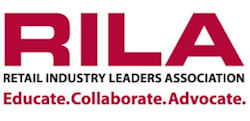|
|

|
|

|
|

|
|
|


|
RILA Report Finds Critical Role for Buyers in Retail Shrink Reduction
Collaboration can address
vulnerabilities early
 Arlington, VA - 9/16/2015 - A
report released today by the Retail Industry Leaders Association (RILA)
outlines the important role that retail buyers, also known as merchants, can
play in reducing shrink. Shrink is defined as the total product lost from the
moment it is purchased from suppliers to the point of sale. Arlington, VA - 9/16/2015 - A
report released today by the Retail Industry Leaders Association (RILA)
outlines the important role that retail buyers, also known as merchants, can
play in reducing shrink. Shrink is defined as the total product lost from the
moment it is purchased from suppliers to the point of sale.
While shrink reduction is traditionally viewed as the sole responsibility of
asset protection professionals, the first-of-its-kind report finds that the
retail professionals responsible for inventory decisions have an important and
under-utilized role to play in reducing shrink.
The report,
"Opportunities and Challenges for Engaging Merchants in the Protection of Retail
Assets" was commissioned by RILA's Asset Protection Leaders Council (APLC)
in partnership with Nicole DeHoratius of the University of Chicago Booth School
Of Business. Checkpoint Systems and EY provided valued sponsorship of the
research project. RILA's APLC is comprised of asset protection pyramid heads
from among RILA member companies and is at the forefront of leading-edge
industry research.
"Shrink reduction is a team effort," said Lisa LaBruno, RILA's senior vice
president for retail operations. "By building relationships across the business
retailers can harness the organization's combined influence and have a
substantial effect on shrink losses."
According to the report, merchants can contribute to shrink reduction by:
●
|
Leveraging supplier relationships to
identify challenges with products and to address issues that could
affect shrink, such as packaging design. |
●
|
Considering security needs, such as
security tags, keepers, locked pegs, spider wrap when selecting
products. |
| ● |
Limiting presentation quantities,
offer testers, and determine product placement on the floor. |
| ● |
Ensuring the integrity of the
process and data used for new product introductions and resets. |
●
|
Considering shrink risk when
determining product flow (e.g., direct store delivery, full case
pack shipment, break pack shipment, etc.). |
 "Much of our research and R&D development revolves around helping retailers
improve on-shelf availability of their merchandise," stated Farrokh Abadi, Chief
Strategy Officer for Checkpoint. "Technology is just an enabler that works best
when incorporated into the thought-process of the merchants all the way to the
store associates, with the end-goal of providing a pleasant shopping experience
to customers." "Much of our research and R&D development revolves around helping retailers
improve on-shelf availability of their merchandise," stated Farrokh Abadi, Chief
Strategy Officer for Checkpoint. "Technology is just an enabler that works best
when incorporated into the thought-process of the merchants all the way to the
store associates, with the end-goal of providing a pleasant shopping experience
to customers."
The report recommends a series of actions that asset protection professionals
should consider in the short term, such as education, training and the adoption
of a common language such as "Inventory Accuracy" that could enhance engagement
with merchants.
"EY is again pleased to join RILA and Checkpoint in supporting this important
research," said Daniel Valerio, Partner, Americas Director, Retail & Wholesale
Sector at EY. "Retail shrink continues to be a significant source of lost
revenues for retailers and we believe this research will help multi-disciplined
teams within the industry stay ahead of the curve in asset protection."
This year-long research project entailed a survey of over 300 buyers and
in-depth interviews with one or more individuals representing 31 retailers that
collectively account for over $1 trillion in US retail sales, or approximately
23% of all US retail sales. The report includes detailed case studies from
several retailers that illustrate their approach to enhanced collaboration and
provides a step by step road map to help asset protection teams improve their
collaboration with merchants.
Key Report Excerpts:
"Today, the term inventory shrink is synonymous with inventory theft - or stock
loss. Thus, retailers commonly seek to prevent inventory shrink through the
adoption of theft prevention techniques within the store, techniques that
include video surveillance, putting products behind glass or devising special
tags for specific merchandise, and investing in alarms at store entry and exit
ways."
"Not surprisingly, we found only 32% of the buyers surveyed viewed the asset
protection team as a partner in efforts to drive sales. In other words, the vast
majority of buyers surveyed perceive the asset protection team to be an obstacle
to retail sales performance."
"With this research, we want to offer an alternative perspective, namely, a
perspective in which shrink is viewed not merely as the result of inventory
theft but rather the accumulation of daily process errors within the retail
store and its supply chain."
"Unlike the term shrink which is analogous to theft and specific theft
solutions, this broader definition of shrink - inventory discrepancies that
arise from poor operational execution - can be a more effective way to engage
buyers and others organizations within the retail chain. This broader definition
can be tied directly to measures that matter to buyers such as sales and product
availability and may enhance their willingness to collaborate on asset
protection efforts. The prevention and correction of process errors requires a
collaborative solution within the retail organization and across firm
boundaries. Asset protection experts need to better understand how such process
errors arise and help educate other members of the retail organization,
including buyers, how their actions ultimately influence the likelihood of such
errors occurring."
| |
|
|
|
|
|

|
|

|
|
|
|
|